
Every month, The Prudent Speculator produces a newsletter that includes a market summary, helpful charts and graphs, recent equity market news, economic outlook and specific stock investment strategies focused on value stock investing. This month, we offer a brand-new stock recommendation, while our Graphic Detail looks at the broadening of the market rally in July and our Editor’s Note provides perspective on the sizable setback over the first two days of August. Note that the entire list is available to our community of loyal subscribers only
Editor’s Note: Market of Stocks, Volatility and the Russell 3000
History shows that a short-term investment orientation can be hazardous to one’s wealth, as studies from data provider DALBAR and others show that most who try to time their moves into and out of stocks often end up with miserable long-term returns. Obviously, with the major equity market averages today still within earshot of their all-time highs and July turning out to be a terrific month for the average Russell 3000 member (see our Graphic Detail), it is relatively easy to buy the argument that the secret to success in stocks is not to get scared out of them.
Of course, as Benjamin Graham said, “The investor’s chief problem—even his worst enemy—is likely to be himself.” We are constantly bombarded with news and analysis that suggest we should be considering major changes in our asset allocations.
For example, stocks rallied on July 31, with The Wall Street Journal stating, “All three major indexes opened sharply higher, holding on to gains after the Federal Reserve held interest rates steady and Chair Jerome Powell signaled the central bank is prepared to cut them in September if inflation keeps moving lower.” The story went on to cite a portfolio manager who said he is nearly certain of a September rate cut as Fed officials want to keep economic growth humming along. “The market definitely likes that,” was his conclusion, suggesting that a friendly Fed was reason to buy stocks at current levels.
However, following a sizable market selloff on August 1, MarketWatch offered this view from a Wall Street economist, “Because the Fed failed to move yesterday, the ongoing deterioration in the economic data as evidenced by today’s rising initial jobless claims, low unit labor costs, and abrupt slowing in global manufacturing activity suggest that we are getting to a point where bad economic news is bad for markets.” That sounds like it is time to sell
Differing views are what make a market, but our enthusiasm for the long-term prospects of our broadly diversified portfolios of what we believe to be undervalued stocks remained unchanged, though we confess to having a tad more optimism with lower prices!
After all, interest rates declined with the yield on the 10-Year U.S. Treasury falling below 4.0%, while a review of the supposedly troubling ISM Manufacturing index and subsequent equity returns shows that the 52 previous quarterly tallies below the offending July 2024 mark of 46.8 were major buy signals for stocks, on average. Indeed, the subsequent 6- and 12-month gains for the S&P 500 index stood at 9% and 17%, respectfully, with those price-return figures not even including dividends.
True, the latest estimate from the Atlanta Fed for real (inflation-adjusted) Q3 U.S. GDP growth declined to 2.5% on August 1, down from 2.8% on July 26, but that is still an impressive number, especially after real GDP growth for Q2 came in at a healthy and better-than-expected 2.8%. Obviously, projections today are not signaling that a recession is on the horizon, but our number crunching provides comfort even on that score. Yes, modest equity losses could be avoided if one knew in advance when a contraction officially began and when it ended, but unless one’s timing was perfect, it is likely that a trader would be sitting on the sidelines before and after an economic contraction, missing out on sizable rewards that include a 9.4% average advance for Value stocks in the 12 months ahead of a recession and a massive 41.3% average gain the 12 months after the contraction concluded
This does not suggest that a market downturn won’t eventually take hold as 10% corrections have hit every 11 months on average while there have been more than a few disappointments this earnings season to go along with some disconcerting headlines domestically and on the global stage. ‘Twas ever thus, as our founder Al Frank was fond of saying, while constantly highlighting data that show that time in the market trumps market timing.
“Data is like garbage. You better know what you are going to do with it before you collect it.” — Mark Twain
Graphic Detail: Market of Stocks
While Value-stock indexes have turned in handsome gains over the last 3, 5, 7, 10 and 20 years, and inexpensively priced stocks have delivered the best long-term returns, the grass of late has been greener on the Growth side of the fence. Of course, we would argue that this bodes very well for the prospects for Value going forward, especially as the Russell 3000 Value index relative to its Growth counterpart is today at levels not seen since the bursting of the Tech Bubble in 2000, even after the wide performance advantage in July in favor of Value.
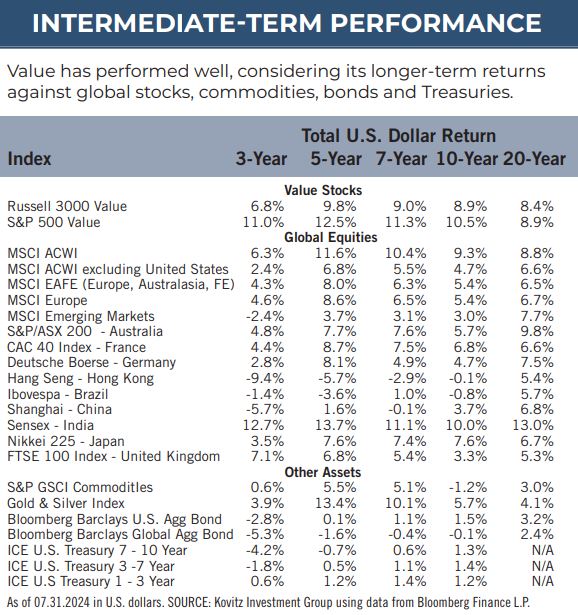
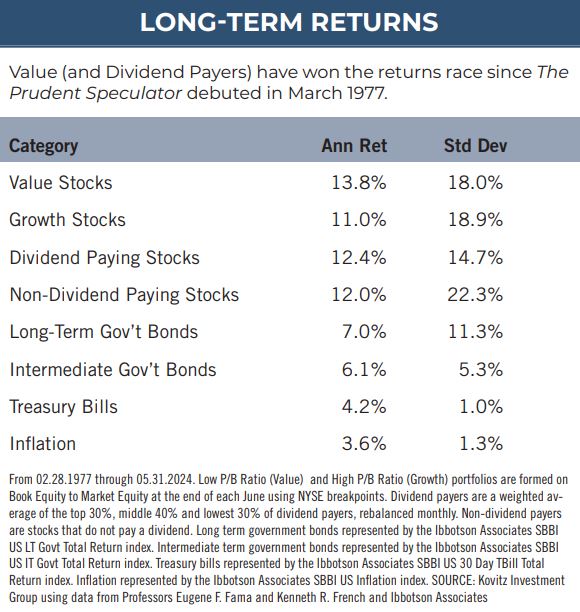
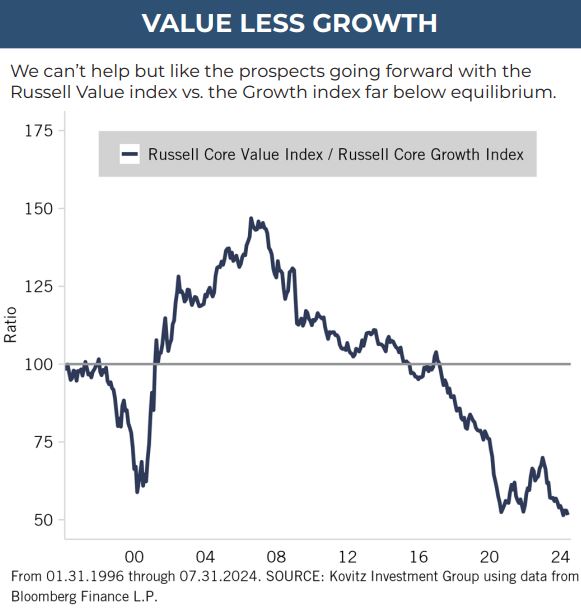
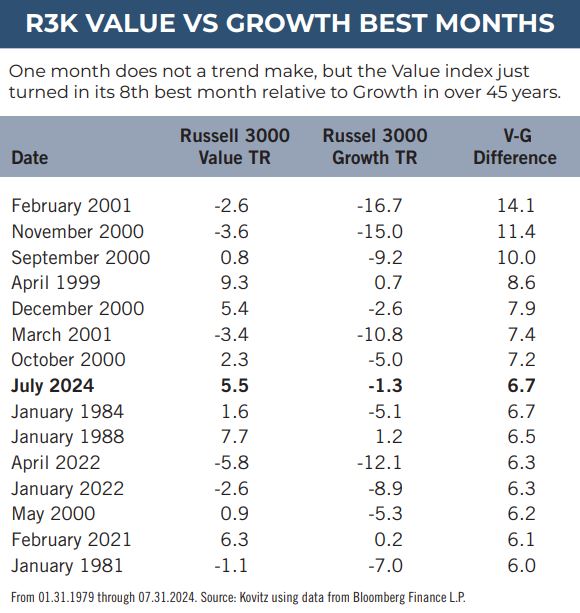
To be sure, a full-fledged Value renaissance hardly is assured, but we are not unhappy to see market participants again focusing more attention on fundamental valuation metrics. True, we have never discriminated by classic definitions of Value and Growth and our portfolios have long sported a much heavier position in Technology stocks and lighter weightings in Financials and Health Care than the Value benchmarks. Also, we have sizable ownership of four (Alphabet, Apple, Meta Platforms and Microsoft) of the so-called Magnificent Seven as well as a handful of AI-exposed names that are now large components of the Russell 3000 Growth index. Still, we enjoy peaceful slumber as the price ratios and yields on our Value-oriented portfolios, including our elevated Tech exposure, are more attractive than those of even the Russell 3000 Value and S&P 500 Value indexes.
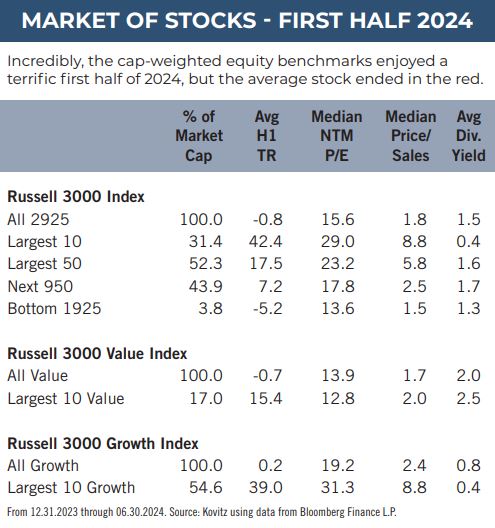
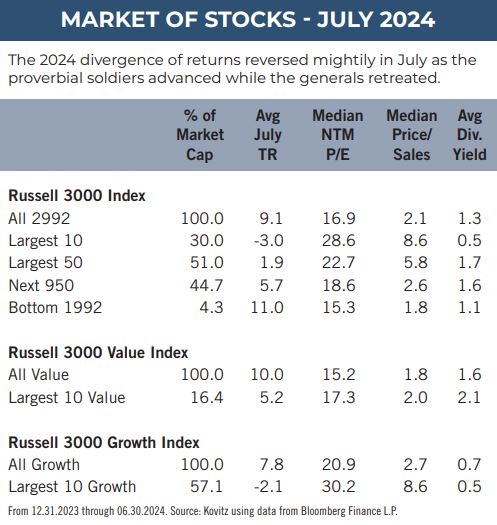
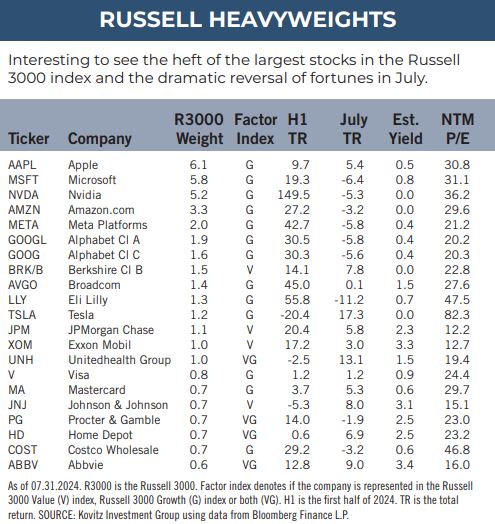
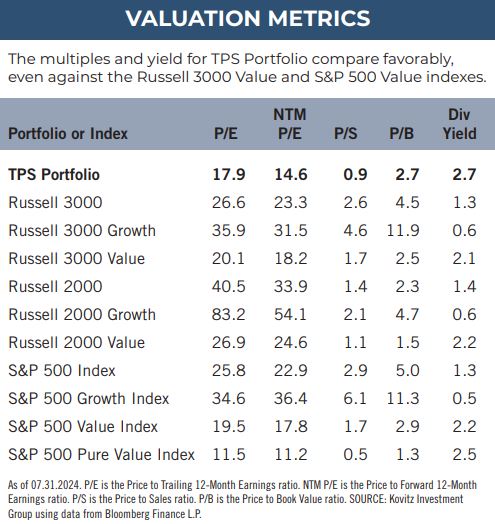
Recommended Stock List
In this space, we list all of the stocks we own across our multi-cap-value managed account strategies and in our four newsletter portfolios. See the last page for pertinent information on our flagship TPS strategy, which has been in existence since the launch of The Prudent Speculator in March 1977.
Readers are likely aware that TPS has long been monitored by The Hulbert Financial Digest (“Hulbert”). As industry watchdog Mark Hulbert states, “Hulbert was founded in 1980 with the goal of tracking investment advisory newsletters. Ever since it has been the premiere source of objective and independent performance ratings for the industry.” For info on the newsletters tracked by Hulbert, visit: http://hulbertratings.com/since-inception/.
Keeping in mind that all stocks are rated as “Buys” until such time as we issue an official Sales Alert, we believe that all of the companies in the tables on these pages trade for significant discounts to our determination of long-term fair value and/or offer favorable risk/reward profiles. Note that, while we always seek substantial capital gains, we require lower appreciation potential for stocks that we deem to have more stable earnings streams, more diversified businesses and stronger balance sheets. The natural corollary is that riskier companies must offer far greater upside to warrant a recommendation. Further, as total return is how performance is ultimately judged, we explicitly factor dividend payments into our analytical work.
While we always like to state that we like all of our children equally, meaning that we would be fine in purchasing any of the 100+ stocks, we remind subscribers that we very much advocate broad portfolio diversification with TPS Portfolio holding more than eighty of these companies. Of course, we respect that some folks may prefer a more concentrated portfolio, however our minimum comfort level in terms of number of overall holdings in a broadly diversified portfolio is at least thirty!
TPS rankings and performance are derived from hypothetical transactions “entered” by Hulbert based on recommendations provided within TPS, and according to Hulbert’s own procedures, irrespective of specific prices shown within TPS, where applicable. Such performance does not reflect the actual experience of any TPS subscriber. Hulbert applies a hypothetical commission to all “transactions” based on an average rate that is charged by the largest discount brokers in the U.S., and which rate is solely determined by Hulbert. Hulbert’s performance calculations do not incorporate the effects of taxes, fees, or other expenses. TPS pays an annual fee to be monitored and ranked by Hulbert. With respect to “since inception” performance, Hulbert has compared TPS to 19 other newsletters across 62 strategies (as of the date of this publication). Past performance is not an indication of future results. For additional information about Hulbert’s methodology, visit: http://hulbertratings.com/methodology/.
Portfolio Builder
Each month in this column, we highlight 10 stocks with which readers might populate their portfolios: Cohu (COHU), TotalEnergies SE (TTE) and Molson Coors (TAP).

Kovitz Investment Group Partners, LLC (“Kovitz”) is an investment adviser registered with the Securities and Exchange Commission. This report should only be considered as a tool in any investment decision and should not be used by itself to make investment decisions. Opinions expressed are only our current opinions or our opinions on the posting date. Any graphs, data, or information in this publication are considered reliably sourced, but no representation is made that it is accurate or complete and should not be relied upon as such. This information is subject to change without notice at any time, based on market and other conditions. Past performance is not indicative of future results, which may vary.







